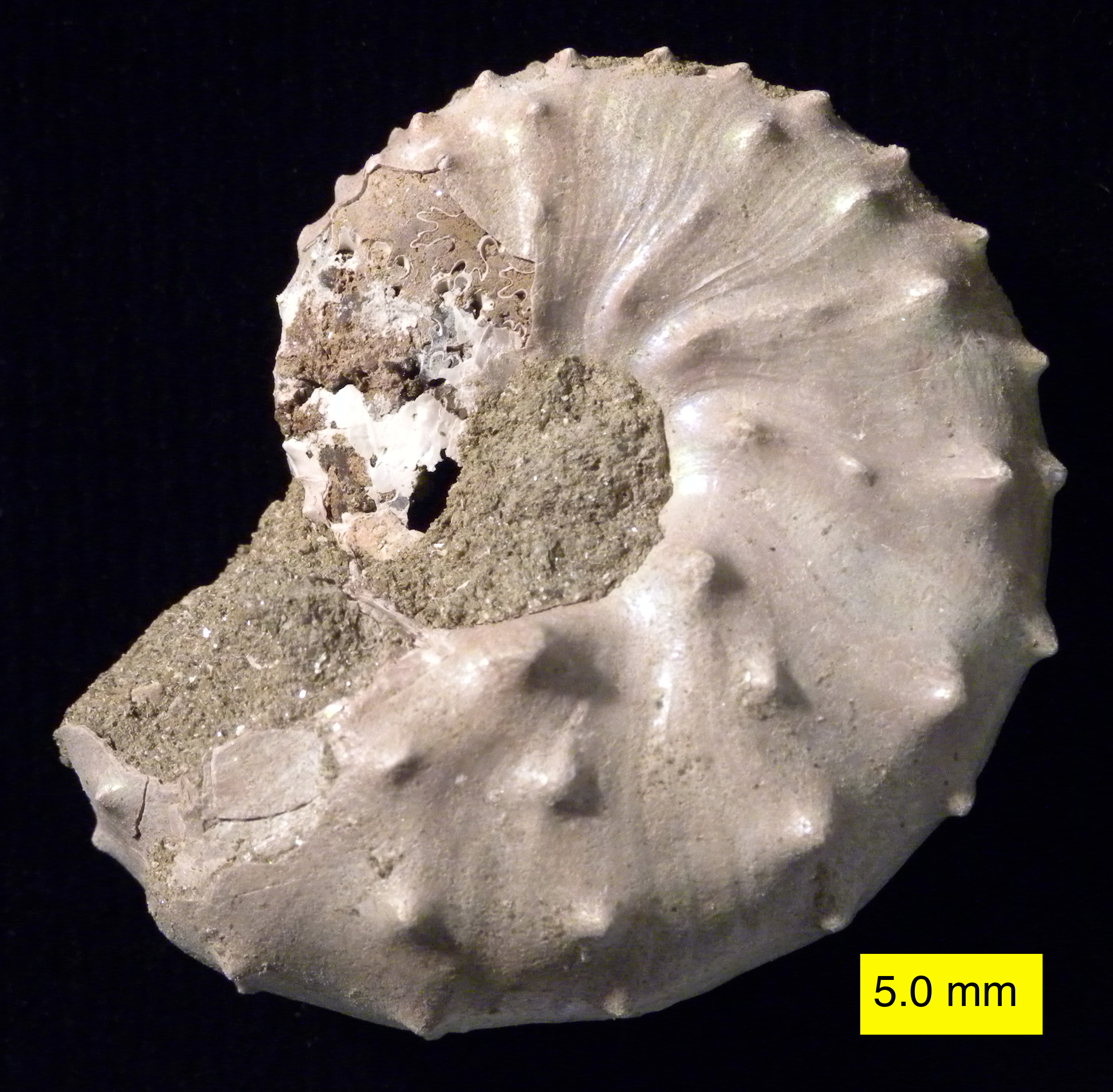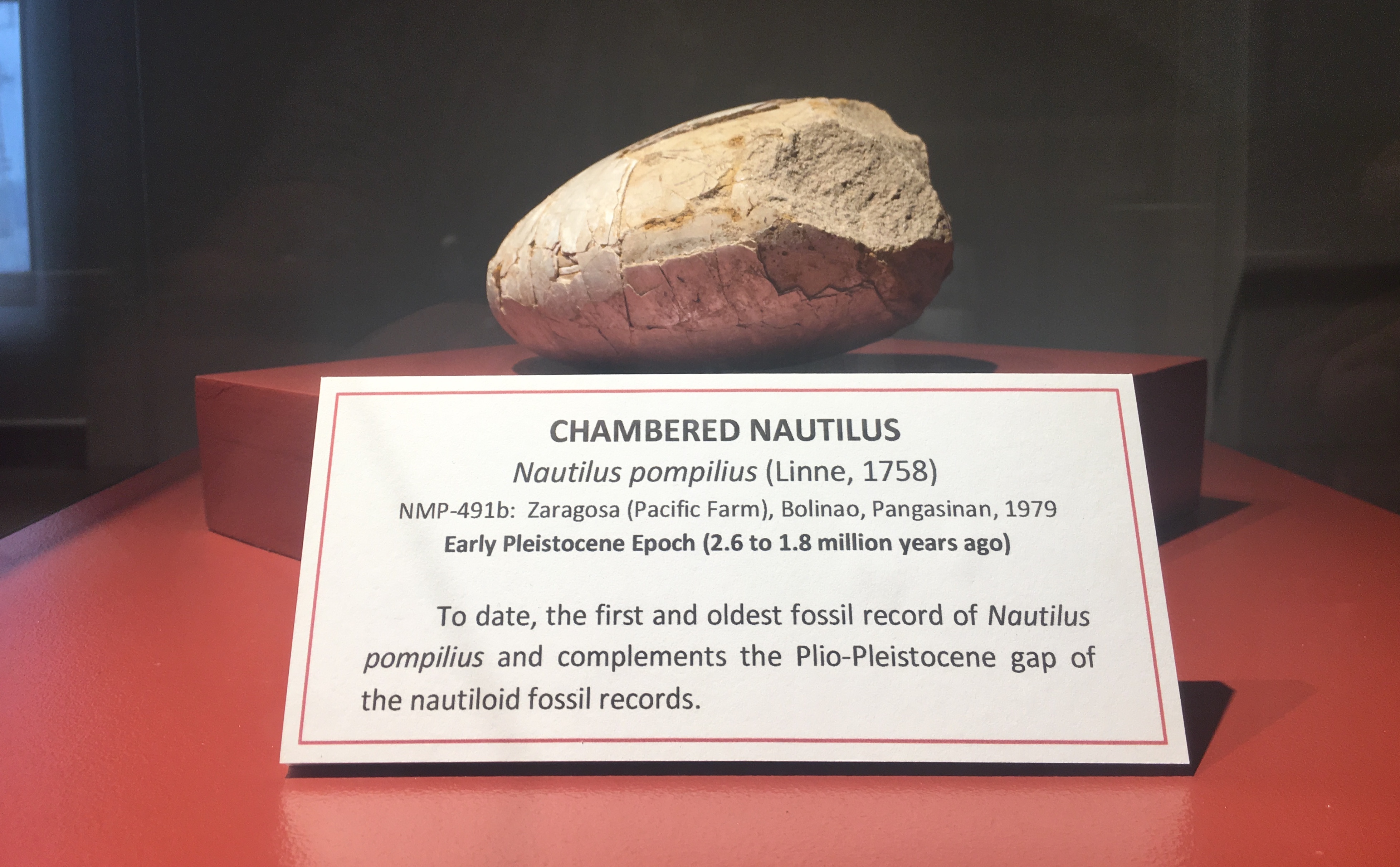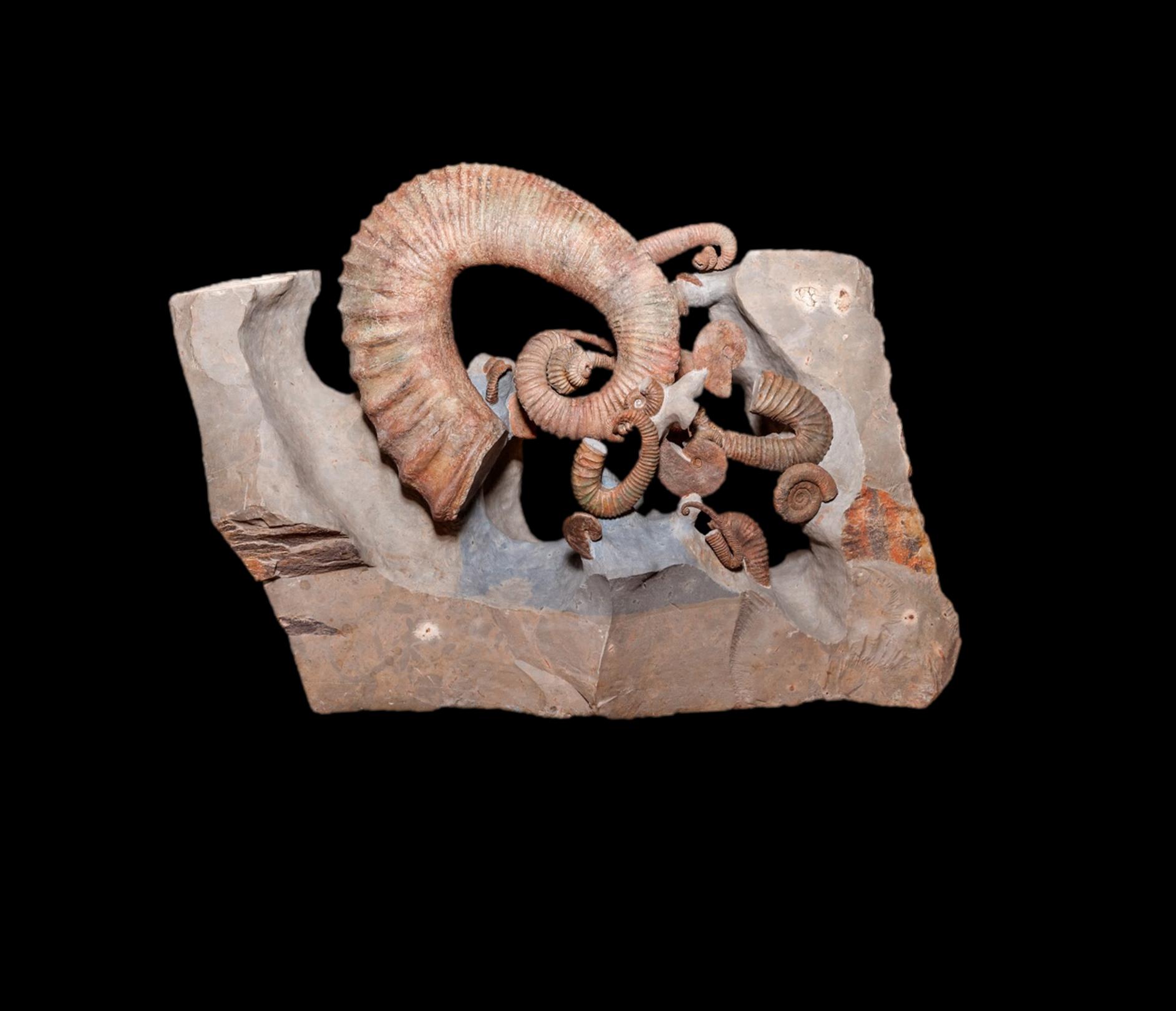|
Ammonoids
Ammonoids are extinct, (typically) coiled-shelled cephalopods comprising the subclass Ammonoidea. They are more closely related to living octopuses, squid, and cuttlefish (which comprise the clade Coleoidea) than they are to nautiluses (family Nautilidae). The earliest ammonoids appeared during the Emsian stage of the Early Devonian (410.62 million years ago), with the last species vanishing during or soon after the Cretaceous–Paleogene extinction event (66 million years ago). They are often called ammonites, which is most frequently used for members of the order Ammonitida, the only remaining group of ammonoids from the Jurassic up until their extinction. Ammonoids exhibited considerable diversity over their evolutionary history, with over 10,000 species having been described. Ammonoids are excellent index fossils, and they have been frequently used to link rock layers in which a particular species or genus is found to specific geologic time periods. Their fossil shells usua ... [...More Info...] [...Related Items...] OR: [Wikipedia] [Google] [Baidu] |
Cephalopod
A cephalopod is any member of the molluscan Taxonomic rank, class Cephalopoda (Greek language, Greek plural , ; "head-feet") such as a squid, octopus, cuttlefish, or nautilus. These exclusively marine animals are characterized by bilateral symmetry, bilateral body symmetry, a prominent head, and a set of cephalopod arm, arms or tentacles (muscular hydrostats) modified from the primitive molluscan foot. Fishers sometimes call cephalopods "inkfish", referring to their common ability to squirt Cephalopod ink, ink. The study of cephalopods is a branch of malacology known as teuthology. Cephalopods became dominant during the Ordovician period, represented by primitive nautiloids. The class now contains two, only distantly related, Extant taxon, extant subclasses: Coleoidea, which includes octopuses, squid, and cuttlefish; and Nautiloidea, represented by ''Nautilus (genus), Nautilus'' and ''Allonautilus''. In the Coleoidea, the molluscan shell has been internalized or is absent, where ... [...More Info...] [...Related Items...] OR: [Wikipedia] [Google] [Baidu] |
Cretaceous–Paleogene Extinction Event
The Cretaceous–Paleogene (K–Pg) extinction event, also known as the K–T extinction, was the extinction event, mass extinction of three-quarters of the plant and animal species on Earth approximately 66 million years ago. The event caused the extinction of all non-avian dinosaurs. Most other tetrapods weighing more than also became extinct, with the exception of some ectothermic species such as sea turtles and crocodilians. It marked the end of the Cretaceous period, and with it the Mesozoic era, while heralding the beginning of the current era, the Cenozoic. In the geologic record, the K–Pg event is marked by a thin layer of sediment called the Cretaceous–Paleogene boundary, K–Pg boundary or K–T boundary, which can be found throughout the world in marine and terrestrial rocks. The boundary clay shows unusually high levels of the metal iridium, which is more common in asteroids than in the Earth's crust. As originally proposed in 1980 by a team of scientists le ... [...More Info...] [...Related Items...] OR: [Wikipedia] [Google] [Baidu] |
Geologic Time Scale
The geologic time scale or geological time scale (GTS) is a representation of time based on the rock record of Earth. It is a system of chronological dating that uses chronostratigraphy (the process of relating strata to time) and geochronology (a scientific branch of geology that aims to determine the age of rocks). It is used primarily by Earth scientists (including geologists, paleontologists, geophysicists, geochemists, and paleoclimatologists) to describe the timing and relationships of events in geologic history. The time scale has been developed through the study of rock layers and the observation of their relationships and identifying features such as lithologies, paleomagnetic properties, and fossils. The definition of standardised international units of geological time is the responsibility of the International Commission on Stratigraphy (ICS), a constituent body of the International Union of Geological Sciences (IUGS), whose primary objective is to preci ... [...More Info...] [...Related Items...] OR: [Wikipedia] [Google] [Baidu] |
Prolecanitida
Prolecanitida is an order of extinct ammonoid cephalopods, the major Late Paleozoic group of ammonoids alongside the order Goniatitida. Prolecanitids had narrow shells, discoidal (disc-shaped) to thinly lenticular (lens-shaped). They retained a retrochoanitic siphuncle, a simple form with septal necks extending backwards. As is typical for ammonoids, the siphuncle sits along the ventral margin of the shell. Prolecanitids form a relatively small and stable order within the Ammonoidea, with 43 named genera and about 1250 species. They were a long-ranging lineage, surviving for about 108 m.y. stretching from the Devonian–Carboniferous boundary to the Early Triassic. Although not as diverse as their goniatitid contemporaries, the Prolecanitida provided the stock from which all later Mesozoic ammonoids were derived. Most prolecanitids had goniatitic sutures. The sutures start at a narrow ventral lobe, which can range from undivided to tridentate (three-pointed). The saddles are ... [...More Info...] [...Related Items...] OR: [Wikipedia] [Google] [Baidu] |
Devonian
The Devonian ( ) is a period (geology), geologic period and system (stratigraphy), system of the Paleozoic era (geology), era during the Phanerozoic eon (geology), eon, spanning 60.3 million years from the end of the preceding Silurian period at million years ago (Megaannum, Ma), to the beginning of the succeeding Carboniferous period at Ma. It is the fourth period of both the Paleozoic and the Phanerozoic. It is named after Devon, South West England, where rocks from this period were first studied. The first significant evolutionary radiation of history of life#Colonization of land, life on land occurred during the Devonian, as free-spore, sporing land plants (pteridophytes) began to spread across dry land, forming extensive coal forests which covered the continents. By the middle of the Devonian, several groups of vascular plants had evolved leaf, leaves and true roots, and by the end of the period the first seed-bearing plants (Pteridospermatophyta, pteridospermatophyt ... [...More Info...] [...Related Items...] OR: [Wikipedia] [Google] [Baidu] |
Emsian
The Emsian is one of three faunal stages in the Early Devonian Epoch. It lasted from 410.62 ±1.95 million years ago to 393.47 ±0.99 million years ago. It was preceded by the Pragian Stage and followed by the Eifelian Stage. It is named after the Ems river in Germany. The GSSP is located in the Zinzil'ban Gorge in the Kitab State Geological Reserve of Uzbekistan , image_flag = Flag of Uzbekistan.svg , image_coat = Emblem of Uzbekistan.svg , symbol_type = Emblem of Uzbekistan, Emblem , national_anthem = "State Anthem of Uzbekistan, State Anthem of the Republ ..., above the contact with the Madmon Formation. In North America the Emsian Stage is represented by Sawkill or Sawkillian time. Biological events During this period, earliest known agoniatitid ammonoid fossils began appearing within this stage after first appearing in previous stage and began to evolutionarily radiate within this stage, in which a new ammonoid or ... [...More Info...] [...Related Items...] OR: [Wikipedia] [Google] [Baidu] |
Clymeniida
Clymeniida is an order of ammonoid cephalopods from the Upper Devonian characterized by having an unusual dorsal siphuncle. They measured about in diameter and are most common in Europe, North Africa, and South China but are known from North America ( New York, Ohio, Oklahoma, and Utah) and Australia (New South Wales) as well. Morphologic characteristics Clymeniids produced a variety of shells ranging from smooth to ribbed and spinose, from evolute with all whorls exposed to strongly involute with the last whorl covering the previous. Some were even triangular in lateral view. With the exception of the first few chambers, all have a siphuncle that runs along the dorsal margin, i.e., along the inner edge of each whorl, rather than the outer edge as in most ammonoids. Developmentally, the siphuncle in clymeniids starts off ventrally, like that in other ammonoids, but after the first few septa it migrates to a dorsal position indefinitely. Septal necks are retrosiphonate, ... [...More Info...] [...Related Items...] OR: [Wikipedia] [Google] [Baidu] |
Nautilus
A nautilus (; ) is any of the various species within the cephalopod family Nautilidae. This is the sole extant family of the superfamily Nautilaceae and the suborder Nautilina. It comprises nine living species in two genera, the type genus, type of which is the genus ''Nautilus (genus), Nautilus''. Though it more specifically refers to the species ''chambered nautilus, Nautilus pompilius'', the name chambered nautilus is also used for any of the Nautilidae. All are protected under CITES CITES Appendix II, Appendix II. Depending on species, adult shell diameter is between . The Nautilidae, both extant and extinct, are characterized by involute or more or less convoluted shells that are generally smooth, with compressed or depressed whorl (mollusc), whorl sections, straight to sinuous Suture (anatomy), sutures, and a tubular, generally central siphuncle.Kümmel, B. 1964. Nautiloidae-Nautilida, in the Treatise on Invertebrate Paleontology, Geological Society of America and Univ of ... [...More Info...] [...Related Items...] OR: [Wikipedia] [Google] [Baidu] |
Goniatitida
Goniatids, informally goniatites, are ammonoid cephalopods that form the order Goniatitida, derived from the more primitive Agoniatitida during the Middle Devonian some 390 million years ago (around Eifelian stage). Goniatites (goniatitids) survived the Late Devonian extinction to flourish during the Carboniferous and Permian only to become extinct at the end of the Permian some 139 million years later. Morphology All goniatites possessed an external shell, which is divided internally into chambers filled with gas giving it buoyancy during the life of the animal. An open chamber at the front of the shell provided living space for the goniatitid animal, with access to open water through a ventral siphuncle. The general morphology and habit of goniatites was probably similar to that of their later relatives the ammonites, being free swimming and possessing a head with two well developed eyes and arms (or tentacles). Goniatite shells are small to medium in size, almost alway ... [...More Info...] [...Related Items...] OR: [Wikipedia] [Google] [Baidu] |
Jurassic
The Jurassic ( ) is a Geological period, geologic period and System (stratigraphy), stratigraphic system that spanned from the end of the Triassic Period million years ago (Mya) to the beginning of the Cretaceous Period, approximately 143.1 Mya. The Jurassic constitutes the second and middle period of the Mesozoic, Mesozoic Era as well as the eighth period of the Phanerozoic, Phanerozoic Eon and is named after the Jura Mountains, where limestone strata from the period were first identified. The start of the Jurassic was marked by the major Triassic–Jurassic extinction event, associated with the eruption of the Central Atlantic magmatic province, Central Atlantic Magmatic Province (CAMP). The beginning of the Toarcian Age started around 183 million years ago and is marked by the Toarcian Oceanic Anoxic Event, a global episode of Anoxic event, oceanic anoxia, ocean acidification, and elevated global temperatures associated with extinctions, likely caused by the eruption of the Kar ... [...More Info...] [...Related Items...] OR: [Wikipedia] [Google] [Baidu] |
Heteromorph
The Ancyloceratina were a diverse suborder of ammonite most closely related to the ammonites of order Lytoceratina. They evolved during the Late Jurassic but were not very common until the Cretaceous period, when they rapidly diversified and became one of the most distinctive components of Cretaceous marine faunas. They have been recorded from every continent and many are used as zonal or index fossils. The most distinctive feature of the majority of the Ancyloceratina is the tendency for most of them to have shells that are not regular spirals like most other ammonites. These irregularly-coiled ammonites are called heteromorph ammonites, in contrast to regularly coiled ammonites, which are called homomorph ammonites. Biology The biology of the heteromorph ammonites is not clear, but one certainty is that their uncoiled shells would have made these forms very poor swimmers. Open shells, particularly ones with spines and ribs, create a lot of drag; but more importantly, the orien ... [...More Info...] [...Related Items...] OR: [Wikipedia] [Google] [Baidu] |
Planispiral
Planispiral is a condition in which a tubicolous shell is coiled in a single horizontal plane and the diameter increases away from the axis of coiling. This term is usually used for describing gastropod shells. Many cephalopod A cephalopod is any member of the molluscan Taxonomic rank, class Cephalopoda (Greek language, Greek plural , ; "head-feet") such as a squid, octopus, cuttlefish, or nautilus. These exclusively marine animals are characterized by bilateral symm ...s and tubeworms can also have a planispiral shell (Allaby and Allaby, 1999). References * External links {{Gastropod anatomy Mollusc shells ... [...More Info...] [...Related Items...] OR: [Wikipedia] [Google] [Baidu] |









